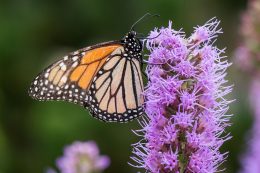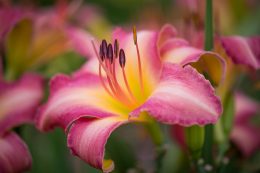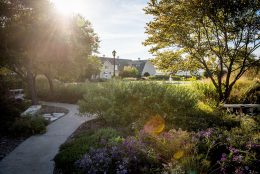
 The K-State Dairy Barn and Milk House (caretaker’s cottage) were built in 1933 in the exact location where they are today. Due to inadequate facilities, the actual dairy production was moved to a new site north of campus in fall 1976. The cottage, which today is the Gardens Visitor Center, once housed student workers who lived upstairs and milked the cows for their rent. The first floor contained a weighing room, milk room, refrigerator, washroom and the herdsman’s office. Today the barn serves as a wonderful educational tool for the university. Used as a head house for the greenhouse operations, it includes research chambers, Insect Zoo and the Gardens Visitor Center.
The K-State Dairy Barn and Milk House (caretaker’s cottage) were built in 1933 in the exact location where they are today. Due to inadequate facilities, the actual dairy production was moved to a new site north of campus in fall 1976. The cottage, which today is the Gardens Visitor Center, once housed student workers who lived upstairs and milked the cows for their rent. The first floor contained a weighing room, milk room, refrigerator, washroom and the herdsman’s office. Today the barn serves as a wonderful educational tool for the university. Used as a head house for the greenhouse operations, it includes research chambers, Insect Zoo and the Gardens Visitor Center.
Butterfly gardening
 Butterfly gardening is becoming more popular with Kansans. Providing for the basic needs of butterflies, such as food, shelter and liquids, will encourage butterflies to visit this summer.
Butterfly gardening is becoming more popular with Kansans. Providing for the basic needs of butterflies, such as food, shelter and liquids, will encourage butterflies to visit this summer.
A number of plants attract butterflies. However, different species of butterflies prefer different plants. Using a variety of plant material that vary in blooming times of day and year helps attract a diverse group of visitors. Plant groups of the same plant together; a single plant is difficult for a butterfly to detect. If trying to attract a certain species of butterfly, learn which plant(s) that butterfly prefers, and then emphasize that plant in your planting. Annuals that attract butterflies include ageratum, cosmos, French marigold, petunia, verbena and zinnia.
Perennials and shrubs can be split into those that bloom early, mid-season and late. Good choices for those that bloom early are allium, chives, forget-me-not and lilac. Bee balm, butterfly bush, black-eyed Susan, buttonbush, butterfly weed, daisy, daylily, gaillardia, lavender, lily, mint, phlox, privet, sunflower and veronica are fitting picks for mid-season bloom. Late bloomers include aster, glossy abelia and sedum.
Remember, there are other ways to encourage butterflies. Butterflies are cold-blooded and like open areas where they can sun themselves on cool days and shade to cool off when the sun is too intense.
Butterflies also need water. A simple way to make a butterfly pool is to take a bucket, fill it with gravel, and bury it to the rim. Now add water, sugar water or sweet drinks so that the butterflies can land on the gravel but still reach the liquid.
Ward Upham—Extension Associate, Dept. of Horticulture and Natural Resources
K-State Open House — activities in the gardens

 The Kansas State University Gardens have several activities lined up for this year’s All-University Open House, Saturday, April 1.
The Kansas State University Gardens have several activities lined up for this year’s All-University Open House, Saturday, April 1.
As part of our maintenance program, we are dividing many of our daylily plants this year. As a fundraiser to support our efforts, we will sell divisions of many of the daylilies in our collection. The sale will be held 10 a.m. to 2 p.m.
In addition to the Daylily Sale, the Friends of the Gardens will promote the “Sjo” Cotton Candy Redbud tree for the gardens. A raffle drawing will be conducted for a chance to win a “Sjo” Cotton Candy Redbud tree, and the Friends of the Gardens will have cotton candy for those participating in the raffle or anyone who donates to the gardens that day. Tickets for the raffle will be sold throughout March and at the All-University Open House, with the drawing at 2 p.m.
If you need to brush up on your shrub pruning skills, Charlie Barden from the Department of Horticulture and Natural Resources will be in the gardens, demonstrating correct pruning practices that will keep your woody plants looking attractive and healthy. Look to join him on the east end of the gardens parking lot at 2 p.m.
Why I care quotables
“ Why do I support the Kansas State University Gardens? Well, The Gardens are a great resource for our community and beyond. They provide a place of peace, and reflection in an artistic setting of beautiful flowers and plants. Why do I support The Gardens? Well, because during these challenging times, I want to help as much as possible. The Gardens are a beautiful place, my donations and volunteer support help them to grow. That is why I support the Gardens; I love them.”
Why do I support the Kansas State University Gardens? Well, The Gardens are a great resource for our community and beyond. They provide a place of peace, and reflection in an artistic setting of beautiful flowers and plants. Why do I support The Gardens? Well, because during these challenging times, I want to help as much as possible. The Gardens are a beautiful place, my donations and volunteer support help them to grow. That is why I support the Gardens; I love them.”
Elizabeth A. Unger, Ph.D.
Vice Provost and Dean, Emerita
Professor of Computer Science, Emerita
Kansas State University
Seasonal tips, garden connections

Students in front row: Madi Culley, Josie Riggs, and Toni Hudspath
March in the Midwest:
(from K-State Research and Extension, Kansas Healthy Yards – Communities)
- Prepare soil for spring planting
- Plant pansies, snapdragons, calendulas, and other cool loving annuals
- Clean up the perennial beds
- Plant new roses and remove winter mulch from existing roses. Prune.
- Spot spray your lawn for dandelions, henbit, and chickweed
- Seed thin areas in bluegrass and tall fescue lawns
- Mow grass 1/2 inch lower to remove winter debris—do not scalp
- Plant potatoes, peas, onions, lettuce and other salad crops
- Plant asparagus, rhubarb and strawberries
- Start seeds inside for tomatoes, peppers and other warm season vegetables
For more tips visit Kansas Healthy Yards!
Upcoming events:
- All-University Open House
- Saturday, April 1, 2017
- 9 a.m.–3 p.m.
- Iris Day at the Gardens
- Sunday, May 14, 2017
- 1–4 p.m.
- Can You Dig It? 13th annual K-State Garden Party
- Friday, June 2, 2017
- 6:30 p.m.
- Music from the ’50s, ’60s, ’70s and ’80s
- Riley County Master Gardener Tour
- Sunday, June 11, 2017
- 1–5 p.m.
Garden connections:
The Gardens are open:
Dawn to midnight, Sunday through Saturday, March through November.
The Quinlan Visitor Center is open:
10 a.m. to 4 p.m. Monday through Friday.
Admission and parking is free.